With the rapid development of the Internet, email marketing has become a part that companies in all walks of life cannot ignore. However, email marketing requires processing a large amount of information, including subscriber management, email sending, marketing report analysis, etc. To handle these complex tasks, using an automated solution can help businesses increase efficiency, save time and cost. This article explains how to build an email automation and marketing automation solution using Java.
- Build a mail server
Building a stable and efficient mail server is the first step in the email automation solution. JavaMail API is an API on the Java platform that uses the mail protocol to send and receive emails. It provides implementations of the SMTP, POP3 and IMAP protocols and can communicate with most mail servers.
When setting up a mail server, you need to pay attention to the following points:
a. Security and reliability of the mail server: Choosing a mail server provider that provides high security and reliability is the best necessary.
b. Email server integration: The email server needs to be seamlessly integrated with other applications, such as CRM or sales automation systems.
c. Scalability of the mailbox server: Enterprises should consider the needs of future business growth and choose a mail server with high scalability.
- Design email templates
Email templates are an important part of an email automation solution. Enterprises need to design attractive and efficient email templates to attract potential customers and obtain more business opportunities from them. JavaMail API in Java can make emails through HTML templates.
When designing an email template, you need to pay attention to the following points:
a. The layout of the email template: The layout of the email template needs to be consistent with the company's brand image, while being easy to navigate and use.
b. Content of the email template: The content of the email template should be concise, clear, and engaging.
c. Scalability of email templates: Email templates should be based on a template engine, making them easy to customize to adapt to changing marketing needs.
- Integrated CRM system
The CRM system is the core system for managing customer channels and customer data. It can help companies understand customer behavior, needs and preferences, and provide them with better marketing opportunities. There are multiple CRM system solutions on the Java platform, including SugarCRM, OpenCRX, JFire and vtiger CRM, etc.
When integrating a CRM system, you need to pay attention to the following points:
a. Integration of the CRM system: The CRM system needs to be seamlessly integrated with the enterprise email marketing automation solution.
b. Scalability of the CRM system: Enterprises need to choose a CRM system with high scalability to adapt to future business growth needs.
c. Data privacy of the CRM system: The CRM system needs to protect the privacy of customer data and meet the requirements of regulations such as GDPR and CCPA.
- Create Email Automation Rules
Email automation rules are the core of an automated email marketing solution. Businesses can create automated email marketing rules based on their audience’s behavior, interests, and preferences. This will help businesses automatically build marketing campaigns and automatically optimize email sending times, thereby increasing customer engagement and business conversion rates.
When creating email automation rules, there are a few things to note:
a. Behavioral triggering of the rule: The rule should be triggered based on the lead’s behavior, such as opening an email or being on a website Browse products.
b. Time triggering of rules: Email automation rules should be triggered based on the correct time. For example, the time to send the email should be during the prospect's free time or after work hours.
c. Rule email content: Rules should contain attractive email content, such as discounts, new product releases, or mall promotions, etc.
- Analytical Marketing Reports
Marketing reports are another important component of an email automation solution. Analytical marketing reports can help companies understand the effectiveness of email sending and provide data support to optimize marketing strategies and rules.
When analyzing marketing reports, you need to pay attention to the following points:
a. Email conversion rate: Email conversion rate is an important indicator for evaluating email marketing effectiveness.
b. Email open rates: Businesses need to increase email open rates to get more engagement rates.
c. Email click-through rate: Businesses need to increase email click-through rates to promote product sales.
Summary
Email automation solutions can help enterprises improve efficiency, save time and costs, and bring more business opportunities to enterprises. The Java platform provides a variety of APIs and solutions that can help enterprises build complete email automation solutions. To ensure successful use of the solution, enterprises need to choose stable, integrated, and scalable email servers and CRM systems, establish easy-to-use email templates, and create automated email marketing rules based on consumer behavior, interests, and preferences. By analyzing marketing reports, companies can optimize marketing strategies and rules to improve the effectiveness of email sending.
The above is the detailed content of How to build an email automation and marketing automation solution using Java. For more information, please follow other related articles on the PHP Chinese website!
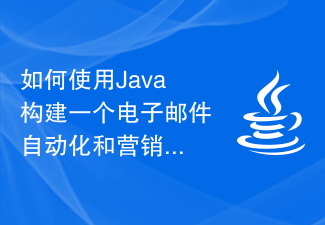 如何使用Java构建一个电子邮件自动化和营销自动化解决方案Jun 27, 2023 pm 05:44 PM
如何使用Java构建一个电子邮件自动化和营销自动化解决方案Jun 27, 2023 pm 05:44 PM随着互联网的快速发展,电子邮件营销已经成为了各行各业的企业都不可忽视的一部分。然而,电子邮件营销需要处理大量的信息,包括订阅者管理、邮件发送、营销报告分析等等。为了处理这些复杂的任务,使用一个自动化的解决方案可以帮助企业提高效率、节省时间和成本。本文将介绍如何使用Java构建一个电子邮件自动化和营销自动化解决方案。建立一个邮件服务器建立一个稳定、高效的邮件服
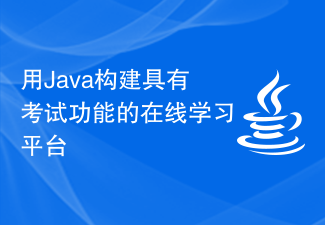 用Java构建具有考试功能的在线学习平台Sep 25, 2023 am 09:51 AM
用Java构建具有考试功能的在线学习平台Sep 25, 2023 am 09:51 AM用Java构建具有考试功能的在线学习平台——代码示例随着互联网的发展和智能设备的普及,在线学习已经成为现代教育的重要形式之一。在线学习平台的构建涉及多个方面,其中考试功能是其中重要的组成部分。本文将使用Java编程语言为在线学习平台构建一个考试功能,并提供具体的代码示例。一、需求分析在构建具有考试功能的在线学习平台前,我们需要明确平台的需求,即平台上的考试应
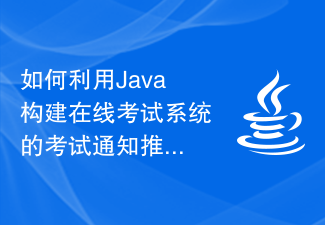 如何利用Java构建在线考试系统的考试通知推送Sep 26, 2023 pm 11:49 PM
如何利用Java构建在线考试系统的考试通知推送Sep 26, 2023 pm 11:49 PM如何利用Java构建在线考试系统的考试通知推送在当代社会中,在线考试系统已经成为了一种非常普遍的考试形式。这种形式的优势在于可以方便地进行远程考试,并且更有效地管理考试的流程。而在在线考试系统中,考试通知的推送是一项非常重要的功能。在本文中,我将介绍如何使用Java构建一个简单的考试通知推送功能,并提供具体的代码示例。一、需求分析在开始编写代码之前,我们需要
 如何利用Java构建在线考试系统的试题难度筛选Sep 25, 2023 am 11:01 AM
如何利用Java构建在线考试系统的试题难度筛选Sep 25, 2023 am 11:01 AM如何利用Java构建在线考试系统的试题难度筛选在现代教育体系中,线上考试已经成为一种普遍的学术评估方式。然而,随着考试试题数量的增加,试题难度的筛选变得尤为重要。为了确保考试的公平性和有效性,试题的难度应该与学生的能力水平相匹配。本文将介绍如何利用Java编写并实现在线考试系统中的试题难度筛选算法,并提供代码示例。一、需求分析在线考试系统的试题难度筛选需要考
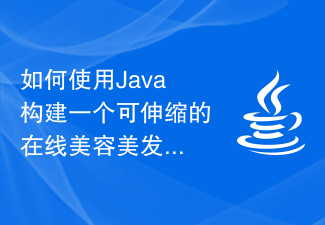 如何使用Java构建一个可伸缩的在线美容美发平台Jun 27, 2023 am 10:32 AM
如何使用Java构建一个可伸缩的在线美容美发平台Jun 27, 2023 am 10:32 AM随着互联网时代的到来,美容美发行业也开始走向数字化和在线化。越来越多的人开始通过在线美容美发平台来获取更加便捷和优质的服务。而Java作为一门具有广泛适用性和强大性能的编程语言,为构建一个可伸缩的在线美容美发平台提供了一种良好的方案。在本文中,我们将探讨如何使用Java构建一个可伸缩的在线美容美发平台,包括数据库的设计、系统的架构和技术的选择。第一步:数据库
 如何利用Java构建在线考试系统的试卷分发功能Sep 25, 2023 pm 04:18 PM
如何利用Java构建在线考试系统的试卷分发功能Sep 25, 2023 pm 04:18 PM如何利用Java构建在线考试系统的试卷分发功能随着互联网的迅速发展,越来越多的教育机构和企业开始使用在线考试系统来方便地组织和管理考试。在这些系统中,试卷分发功能是其中非常重要的一部分,它能够自动将试卷分发给考生,实现试卷的安全存储和传输。本文将介绍如何利用Java构建在线考试系统的试卷分发功能,并提供具体的代码示例。一、需求分析在开始编写代码之前,我们需要
 如何使用Java构建一个可伸缩的在线交友平台Jun 27, 2023 am 09:48 AM
如何使用Java构建一个可伸缩的在线交友平台Jun 27, 2023 am 09:48 AM随着社交媒体的发展,人们越来越喜欢使用在线交友平台来寻找朋友或恋人。随之而来的是,这些平台面临着越来越大的用户量和数据量的挑战。如何构建一个可伸缩的在线交友平台,成为了开发者们面临的重要问题。本文将介绍如何使用Java构建一个可伸缩的在线交友平台。选用适当的架构首先,我们需要选择一个适当的架构来构建我们的平台。基于Java的Web应用程序通常使用Model-
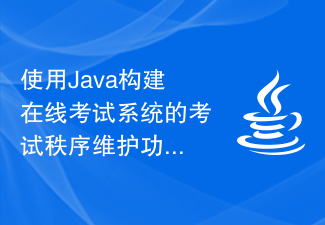 使用Java构建在线考试系统的考试秩序维护功能Sep 25, 2023 pm 05:51 PM
使用Java构建在线考试系统的考试秩序维护功能Sep 25, 2023 pm 05:51 PM使用Java构建在线考试系统的考试秩序维护功能,需要具体代码示例随着互联网的普及和技术的发展,传统的纸质考试逐渐被在线考试系统所取代。在线考试系统具有方便、高效、准确等优势,广泛应用于各类考试场合。其中,考试秩序维护是在线考试系统中的一个重要功能,其主要目的是确保考试的公平、公正和安全。在线考试系统的考试秩序维护功能主要包括对考生的身份验证、考场监控、违规监


Hot AI Tools

Undresser.AI Undress
AI-powered app for creating realistic nude photos

AI Clothes Remover
Online AI tool for removing clothes from photos.

Undress AI Tool
Undress images for free

Clothoff.io
AI clothes remover

AI Hentai Generator
Generate AI Hentai for free.

Hot Article

Hot Tools

SecLists
SecLists is the ultimate security tester's companion. It is a collection of various types of lists that are frequently used during security assessments, all in one place. SecLists helps make security testing more efficient and productive by conveniently providing all the lists a security tester might need. List types include usernames, passwords, URLs, fuzzing payloads, sensitive data patterns, web shells, and more. The tester can simply pull this repository onto a new test machine and he will have access to every type of list he needs.

MinGW - Minimalist GNU for Windows
This project is in the process of being migrated to osdn.net/projects/mingw, you can continue to follow us there. MinGW: A native Windows port of the GNU Compiler Collection (GCC), freely distributable import libraries and header files for building native Windows applications; includes extensions to the MSVC runtime to support C99 functionality. All MinGW software can run on 64-bit Windows platforms.

SublimeText3 Mac version
God-level code editing software (SublimeText3)

SAP NetWeaver Server Adapter for Eclipse
Integrate Eclipse with SAP NetWeaver application server.

Zend Studio 13.0.1
Powerful PHP integrated development environment






